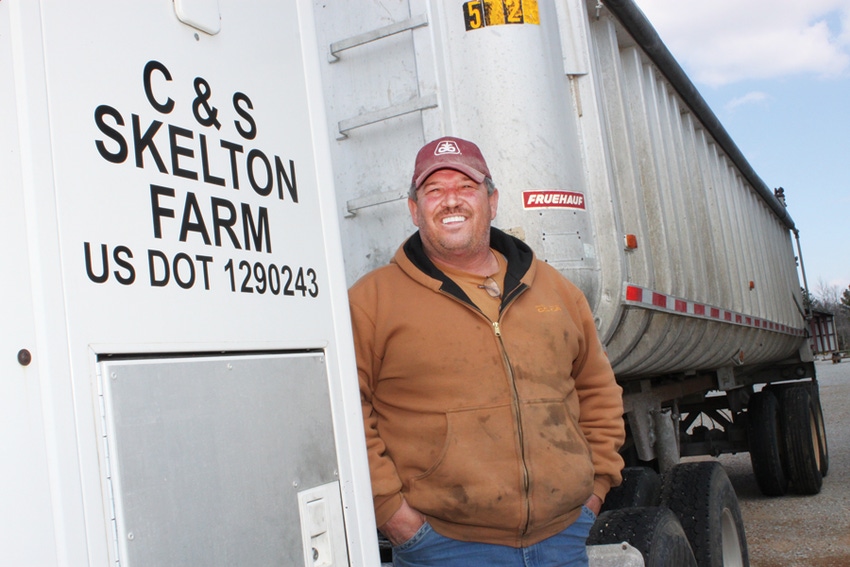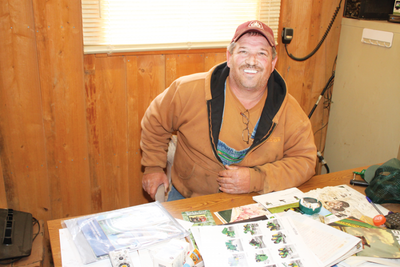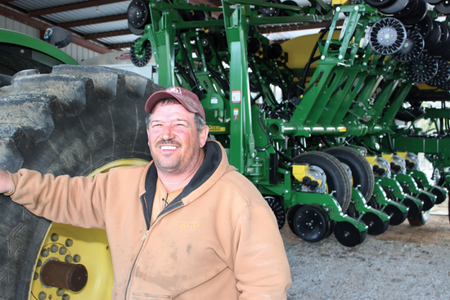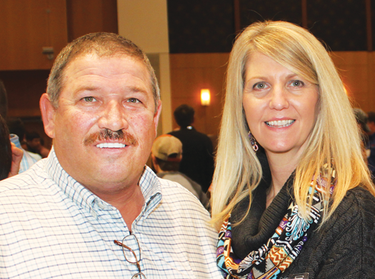
Steve Skelton: Overcoming tragedy to keep farm going
"Although I’d grown up on the farm, and farming was all I’d really ever known, I hadn’t been involved in the business end of it," says Ashland, Miss., farmer Steve Skelton. "I was the seed man, the planter man, the chemicals man, and my father took care of the financial end of things. When he was incapacitated in an accident, all of a sudden I was faced with doing it all. I was thrown into a position with the farm for which I’d had no preparation.”

In the blink of an eye, Steve Skelton’s role in his family’s farming operation was changed, and he suddenly found himself confronted with responsibilities and challenges for which he had no previous experience, but which were critical to the farm’s future.
Even now, going on five years later, the sadness and loss are reflected in his eyes and his voice as he tells the story.
“It was 2008, my father, Charlie Skelton, and I had just finished gathering our crops, and some of our cows got out. We went to the pasture to round them up, and while we were there Daddy said we might as well do some fence repair. We were clearing trees with chain saws and one fell and hit him on the head.
“He was in the hospital in a coma for a while, and when he came home he had no use of his body. He couldn’t carry on a meaningful conversation. My mother, Rose, my sister, Cindy Wilson, and I were his caregivers for two years until he died.”
As bad and as heartbreaking as that was, Steve says, “I was thrown into a position with the farm for which I’d had no preparation. Although I’d grown up on the farm, and farming was all I’d really ever known, I hadn’t been involved in the business end of it. I was the seed man, the planter man, the chemicals man — and that suited me fine. Daddy took care of the financial end of things. Now, all of a sudden, I was faced with doing it all.”
Attempts to discuss farm business with his father were fruitless, Steve says. “He just wasn’t able to communicate.”
Some time later, out of the blue, his father saw his dog wandering by and said, “Why, there’s old Doc.” It was his first recognition of anything since the accident.
“One Sunday morning after that, I helped him into the pickup to go for a ride around the farm. I had an Alan Jackson CD playing, ‘I Want to Stroll Over Heaven With You.’ Daddy started crying, then began talking to Sam, one of his farmhands who was riding with us. He began telling Sam about our cows, when he’d bought them, stories about them. It was as if his memory was coming back.
“His mind got good enough that he was able to go to the bank and get paperwork done for me to take over the farm. When corn planting time came in 2009 — my first time to run the farm all by myself — he’d talk to me every day, ask how things were going.
“Then, just as suddenly as his mind had returned, it was gone again. He never recovered, and he died in 2010. But that short time we had together helped me to find the strength and determination to move forward and do what needed to be done to keep the farm going.
Support of family and friends
“It hasn’t been easy,” says Steve, “but we’ve hung in there. My family has been very supportive. My mother continued to keep the farm’s books, as she had done for 50 years, until she recently turned that over to my wife [Leigh, who is manager of the Mid-South Farmer’s Co-op at Ashland, Miss.]. My good friend and neighboring farmer, Matt Ormon, has been there for me with help and advice, as have others — and that has meant a lot.”
READ ABOUT STEVE'S FRIEND: Matt Ormon took a chance on a farming career
Steve’s stepson, Larry Mason, who worked for Coldwater Cattle Company for several years, has been working with the farm for about two years, and Steve says, “I’m hoping he will want to continue to be a part of the operation. Larry’s 12-year old daughter, Hannah, likes to do things on the farm with us — she’s a real delight.”

HIGH LAND RENT and deer were reasons Steve Skelton gave up some of the land he had been farming.
One thing Steve has done since his father’s death is to slightly scale back the operation.
“Daddy and my uncle, Bud Skelton, started farming together 50 years ago. They had no land, were just sharecroppers. When I got out of school in 1986, they were farming 2,000 acres of row crops, mostly rented land, plus about 1,400 acres they owned that was primarily pastures.
“I started out farming on my own, but we were all sharing equipment and doing things across all of the farms, and it was just aggravating to try and keep things separate, so we formed a three-way partnership. In 1999 Daddy and I bought out Uncle Bud, who later died. We were growing cotton, corn, soybeans, and had pasture land and cows.”
Now, Steve says, he has 1,600 acres in row crops, about a fourth owned, the rest rented, plus pastures and cows.
“I was farming some land across in Tennessee [the state line is only 25 miles away], but rents were much higher there —$130 to $140 per acre for dryland — and that just wouldn’t pencil out, so I turned it loose. I also let some other land go here because deer were so bad I couldn’t make crops.”
Benton County, where Steve is located near the town of Ashland, is the seventh smallest county in the state, with a population just over 8,000. Much of the land area is taken up by the 55,000-acre Holly Springs National Forest, plus a lot of private timberland. There are also a number of small hobby/weekend farms owned by residents of Memphis, Tenn., many of whom don’t want deer killed.
“I’ve counted as many as 75 deer in a field,” Steve says. “They can absolutely wipe out a stand of soybean seedlings or corn. Wild hogs have not yet been a problem for me, although people in adjoining counties have had trouble with them, and it’s probably just a matter of time until I get them, too.”
Steve’s operation includes 36 different farms, spread over a 35-40 mile radius, and 10 different pastures, scattered in all directions. “It takes a lot of travel,” he says. “There are years I’ll put 100,000 miles or more on a pickup. And moving equipment is a challenge on our hilly, narrow, twisting highways.”
Wheat added to boost income
He is growing wheat this winter for the first time, trying to generate a bit more income. That 450 acres will be double-cropped to soybeans, and he’ll have 600 acres of full-season beans and 550 acres of corn.
“We quit cotton in 2006,” he says. “Daddy and Uncle Bud had always grown cotton, and I grew up with it. I remember all too well being on a sprayer seven days a week, trying to stay ahead of the boll weevils.
“The best we could hope for in yield was a bale and a half, and with prices as they were and input costs as they were, it just wouldn’t pay. In 2006, we averaged 1-1/2 bales, a good crop, but went in the hole $20,000. We parked our two 4-row pickers under the shed and finally sold them in 2011.
“I couldn’t get used to all the free time when we weren’t growing cotton any more,” he laughs. “But, that didn’t last long — other work quickly filled the gap. Every now and then, I think about growing cotton again, but the thought quickly passes. There’s no way I could make the kind of investment needed to get back into cotton.

A NEW John Deere planter with auto-steer and individual row control is Steve Skelton’s latest equipment addition.
“Too, it’s practically impossible to find farm labor any more, particularly those you can turn loose with expensive equipment. They want to do everything in a hurry, which too often leads to costly mistakes. And young folks just don’t care anything about farm work.
“I’ve just bought a new 1790 John Deere planter, which has auto-steer and individual row controls. The technology is new to me, and it will take some learning — but I’ll figure it out on my own, and I’ll make sure it’s operated properly and things are done right.”
He has four John Deere tractors, an 8220, two 7430s, and a 4650, and an old International 7140; a John Deere 9770, with a 30-foot draper header, auto-steer, and yield monitor; a John Deere 67000 sprayer; two grain trucks, and four new hopper bottom trailers.
ANOTHER YOUNG FARMER'S STORY: For Andy Milstead, row crops and cows a winning combination
“I don’t have any on-farm storage,” Steve says. “All my grain is sold at Cargill, ADM, or Bunge in Memphis. I do some forward contracting, although I’m not big on contracting a lot of corn ahead because I’m always worried that drought or aflatoxin, or both, might hurt yield enough that I couldn’t meet my contract.
“I don’t know what to expect from the wheat, given that I have no previous experience with it. Some of it looks a little ragged after the hard winter we’ve had, but I’m hoping it will turn out OK.
“In most years, corn will average 125 bushels. All my farms are non-irrigated hill land and everything is terraced — I have no bottom land. Except for a couple of farms, irrigation just isn’t feasible, and I’m not sure I could justify that kind of investment.”
2013 'a super year for corn'
Last year, he says, was “a super year” for corn, despite the late start with the cold, wet spring. “It averaged 165 bushels, the best I’ve ever had. When I saw the numbers while combining, I thought the yield monitor wasn’t calibrated correctly. One farm averaged 187 bushels, with some spots cutting 240 to 250 bushels. Another farm averaged 184 bushels — that’s really phenomenal for dryland corn in the hills.

STEVE SKELTON and his wife, Leigh, who is manager of the Mid-South Farmers Co-op at Ashland, Miss.
“I planted mostly Pioneer varieties last year, 33N58 and P1319, and a small amount of Dekalb 6449. I’ll be all Pioneer this year.” Weather permitting, he hoped to start planting April 1.
Soybeans averaged 32 bushels last year — all Pioneer: 94Y70, 95Y10, and 94Y90. “I’ll be all Pioneer again this year, 94Y61, 95Y10, 95Y70, and two new varieties, 49T80, and 49T97.
“I try and follow a corn one year, soybeans two years rotation. I’m 100 percent no-till — I still remember Daddy’s skepticism when I no-tilled cotton — and it has worked well, saving energy, labor, and equipment hours. I soil test and apply lime as needed. I’ll put out 100 units of nitrogen on the corn, along with 100 pounds each of potash and phosphate.
“Years ago, Daddy and Uncle Bud had 500 head of hogs and we were growing corn for feed when nobody else was growing corn, so I’ve had a lot of experience with the crop.”
There have been a few problems with resistant marestail, Steve says, “but so far no resistant pigweed. I rotate chemistry to try and avoid problems. For corn burndown this year, I’m using Roundup and 2,4-D, and for soybeans, Roundup, 2,4-D, and Valor. On the wheat ground, I used Finesse.”
On the livestock side of the operation, Steve says he runs 200 head of brood cows, mostly Charolais and Black Angus. “I try to wean calves in October-November, then put them on feed for 90 days to pre-condition them and get them vaccinated and ready to go to the feedlot in early spring. In February, I sold 158 head — 99 steers and 59 heifers.
YOU MIGHT ALSO LIKE: Keith Morton is always looking for ways to do things better
“Most of my sales have been through sale barns, but I’m also trying to do more direct sales in order to eliminate commissions, which can really eat into profits.”
“I have 230 acres of Tifton 44 bermudagrass, and usually put up 1,500 to 1,800 big round hay bales each season. I’ll put out some protein tubs for the cows in the winter and I buy feed for the calves from the co-op.
“I’ve got 59 heifers now that I’ll put with bulls in June and 50 other heifers that are having calves. Although beef prices have been quite high, and the consumer looks at supermarket prices and thinks the cattleman is getting rich, the fact is I’m not putting any more money in my pocket at today’s prices than I was 15 years ago, because costs of feed and other inputs have risen so much.
“For example, 103 tons of feed for the calves this winter was $20,000, and fertilizer, seed, and other costs for the Tifton bermudagrass pastures was $42,000. Then, there’s rent, vet bills, transportation — it all adds up pretty quickly.”
About the Author(s)
You May Also Like



